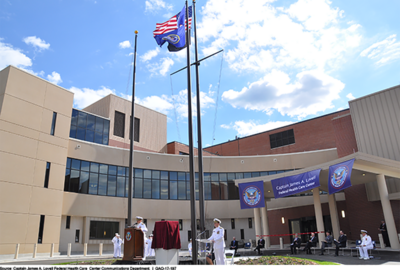VA seeks higher pay caps for more health care workers to address high turnover rates
The Department of Veterans Affairs, faced with thousands of job vacancies and a high rate of turnover among its health care workforce, is calling on Congress to set...
The Department of Veterans Affairs, faced with thousands of job vacancies and a high rate of turnover among its health care workforce, is calling on Congress to set higher pay caps for more occupations, and permanently ease onboarding requirements.
Congress passed the RAISE Act as part of the fiscal 2022 omnibus spending package, which sets higher pay caps for VA’s registered nurses and physician assistants.
That, however, is just the start in terms of what the VA is asking from Congress, in order to recruit and retain in-demand health care workers.
Jessica Bonjorni, the Veterans Health Administration’s chief of human capital management, told the House VA Committee that the agency is calling for lawmakers to pass legislation that would set higher pay caps for other positions.
“In addition to the RAISE Act, which is going to be great for us, there are a variety of other occupations in addition to nurses and physician assistants who will need some assistance in modifying pay caps,” Bonjorni said Thursday.
Bonjorni said the agency is also looking for streamlined hiring authority.
“Our hiring authorities are too complex right now, and so having a simplified, streamlined version that would allow HR staff to have an easier time bringing people on board would be helpful,” she said.
Even if Congress sets higher maximum pay for other VA employees, Bonjorni said the agency needs to find other ways, including benefits and improving morale, to recruit and retain health care workers.
“While we appreciate what we have been given with the RAISE Act, we know that VA still can’t be the pay leader, so we have to be the employer of choice. That’s particularly true for our nursing workforce,” Bonjorni said.
Bonjorni said VHA saw an 8.8% turnover rate for nurses last fiscal year, but sees an increasing turnover for entry-level positions including housekeeping, food service, medical technologists and health techs.
Gina Grosso, VA’s assistant secretary for human resources administration/operations, security and preparedness, said the agency has historically seen a low and “extremely competitive” turnover rate of 9.6% or lower annually for its workforce.
However, last fiscal year that turnover rate increased to 9.9%, because of private health care systems offering higher wages and bonuses, as well as burnout and stress from the COVID-19 pandemic.
Grosso said it remains uncertain if the VA will be able to keep turnover less than 10% through the next fiscal year.
“I don’t want to predict the future, but we are seeing the numbers moving in the wrong direction,” Grosso said.
Bonjorni said that at this point in the fiscal year, VHA would normally see its workforce grow by about 2%, but so far that growth has been flat.
“We are still trending behind because it’s becoming more difficult to find people out there for certain occupations,” Bonjorni said.
The VA recently stood up its Reducing Employee Burnout and Optimizing Operational Thriving (REBOOT) task force to improve systems and processes that contribute to burnout at its medical facilities.
The agency also recently released a 10-point human infrastructure plan focused on reinvigorating the VA workforce and address the highest turnover among its nurse workforce in 15 years.
Grosso said VHA is going through a human resources modernization focused on standardizing HR processing and increasing efficiency. VHA, she added, has also created an “onboarding optimization team,” focused on fast-tracking the pre-employment and onboarding process for new hires.
The agency is also developing staffing models across VA, including medical centers. Grosso said these models will help each VHA network “allocate resources that will produce the best outcomes.”
Health care workers make up nearly 90% of the VA’s workforce of more than 400,000 employees. Veterans make up nearly 30% of the VA’s workforce.
Committee wary of VA’s plan to make pandemic onboarding procedures permanent
The VA is also looking for help to recruit entry-level staff, and is urging lawmakers to extend authorities in the CARES Act that eased VA hiring regulations and reduced restrictions on pay and bonuses.
Bonjorni said a team of process improvement engineers is looking at ways to revamp the VA’s onboarding process. Options include allowing the VA to keep temporary flexibilities on background checks in place.
“One of the things I believe they’re going to recommend is that we make those actions permanent that would allow us to bring people on quickly and still have the opportunity, if there’s an issue with their background, to go ahead and let them know that they can’t continue employment with us, but we’d get them in the door quickly,” Bonjorni said.
The committee’s leadership, however, expressed reluctance in allowing VA to permanently ease onboarding requirements.
Committee Chairman Mark Takano (D-Calif.) said making these COVID-era onboarding flexibilities permanent comes with a level of “inherent risk.”
“It’s not difficult to imagine the worst-case scenario, if those tasks are not completed in a timely manner or at all. VA could end up employing unqualified, clinically incompetent individuals with criminal backgrounds, people who would be delivering health care to our veterans while having access to controlled substances and veterans’ sensitive health information. And those risks would absolutely have to be mitigated before I could support changing the existing law,” Takano said.
Committee Ranking Member Mike Bost (R-Ill.) also expressed concerns about the proposal to permanently ease onboarding requirements.
“The worst thing that could happen is one of our veterans suffer in one way or another by somebody who is either incompetent or has a criminal background. That would be a danger,” Bost said.
Bonjorni said the VHA tracks the completing of onboarding tasks, including fingerprinting background checks, and full verification of clinical qualifications, through its USA Staffing System.
VA looks to roles for non-vaccinated employees
The VHA currently has 50,000 vacancies, which includes doctors, nurses, schedulers, social workers and housekeeping aides.
Republicans on the committee urged the agency not to fire any of the nearly 40,000 employees who have requested an exemption to its COVID-19 vaccine mandate for health care workers.
“Veterans are waiting weeks or months for care in certain areas, and in certain cases, staffing shortages will only make those wait times longer. That could have life or death consequences for veterans,” Bost said.
Grosso said the agency isn’t questioning the legitimacy of any religious or medical exemptions. However, the VA is also looking for places for these employees to work that doesn’t put the health of patients at risk.
“We are not questioning the validity of someone’s request for a religious or medical issue. But what we are trying to do is make sure that we have a safe environment for the veterans that we serve, and so we are working for those individuals to find a place where they can work,” Grosso said.
“Our sincere desire is not to lose anybody, and we are doing our best to accommodate all those individuals that have asked for it,” Grosso added.
Bonjorni said options include reassigning non-vaccinated employees from working with high-risk patients, or moving them to virtual work.
“All options are on the table before we take any type of administrative steps to take any kind of action against an employee,” she said.
VA workforce to grow under plans to rethink real estate
The VA, earlier this week, released its recommendations to the Asset and Infrastructure Review (AIR) Commission.
The agency, as part of these plans, is looking to right-size its sprawling network of medical facilities across the country, and is planning to close or overhaul facilities that no longer meet the health care needs of veterans.
Takano said the committee plans to hold a hearing soon on the VA’s recommendations to the Commission but is still reviewing the recommendations, including what they might mean for the agency’s human capital needs.
“VA can improve buildings and build new facilities closer to where veterans live, but if VA does not have the workforce to staff them, it cannot deliver on our promise to veterans,” Takano said.
Despite VA recommending an overall reduction in the number of VA medical centers and outpatient points of care, Grosso said the agency in the long run “will actually need more employees, not less employees.”
“I believe it’s too soon to see staff changes. But we’ve been working very hard to let our employees know that they are important. And in fact, that was one of our biggest concerns when the report was released. We need our employees, we need them now, and we’re going to need them in the future. And we have a place for them in the future, that’s really our message. No matter what decisions are made, nothing is going to happen most likely within the next five years, so even if employees are nervous, we’re trying to let them know that nothing is imminent in your position,” Grosso said.
The release of these recommendations to the AIR Commission report kicks off a year-long process of the commission reviewing the recommendations, holding public hearings and submitting its own recommendations to Congress and President Joe Biden by the end of January 2023.
Copyright © 2025 Federal News Network. All rights reserved. This website is not intended for users located within the European Economic Area.
Jory Heckman is a reporter at Federal News Network covering U.S. Postal Service, IRS, big data and technology issues.
Follow @jheckmanWFED
Related Stories






